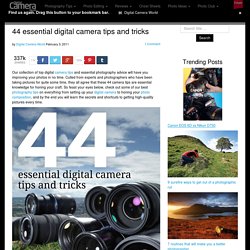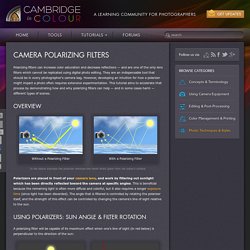

iPhoneography Apps. How to Be a Curious Photographer. Basics of Photography: The Complete Guide. 44 essential digital camera tips and tricks. Our collection of top digital camera tips and essential photography advice will have you improving your photos in no time.

Culled from experts and photographers who have been taking pictures for quite some time, they all agree that these 44 camera tips are essential knowledge for honing your craft. So feast your eyes below, check out some of our best photography tips on everything from setting up your digital camera to honing your photo composition, and by the end you will learn the secrets and shortcuts to getting high-quality pictures every time. Digital Camera Tips: 01 Always reset camera settings There are few things worse than taking what you think is a stunning picture, only to find your camera’s ISO and saturation were cranked right up from a previous shoot and you’ve missed the moment. Monosnaps ...... eddiemallin. Susan Burnstine Photography. Love the blur. Moominstuff. Becky Ramotowski. Photosteph. The Holga Darkroom. Push Processed. Shadowhouse Creations. Digital Blending. This subject is featured in Issue #6 of The Luminous Landscape Video Journal.

The Problem Being Solved In nature when doing landscape work that includes sky, especially early or late in the day, the contrast range encountered often exceeds that which film or imaging chips can handle. It's therefore necessary to find a way to reduce the contrast range to something that the camera can handle so that the highlights don't burn out and the shadow areas don't turn inky black.
The Traditional Approach The traditional method of dealing with this is to use split neutral density filters (graduated filters, some call them). This works well much of the time, and I have rarely gone out shooting without my full filter kit at the ready. 1 stop, 2 stop and 3 stop grads, and soft and hard edged versions of each. An additional downside is that using them takes time. Is there a better way? Shooting Technique What you're going to do is take at least two separate frames of the scene.
Common First Steps Fig. 1. Article on Increasing Depth of Field through Focus Combining. Trouble Signing In?

We apologize if you are having problems signing in. With our latest website upgrades there have been some changes that may cause a sign in problem until cookies are cleared using the steps below. Delete Board and Browser Cookies. Hand-Held Flash Macro Photography. 60+ (more) Advanced Photoshop & GIMP Tutorials. Skip to content Dennis Plucinik's Web Design Blog Just another WordPress site advertisements Follow Me 60+ (more) Advanced Photoshop & GIMP Tutorials Posted on February 8, 2008 by dennisplucinik in Design | Tagged with: Adobe, GIMP, Photoshop, tutorials Before getting started, I want to give a shout out to Collis down at psdtuts.com.

Gimp Tutorials - Search for Gimp Tutorials on Pixel2Life. GimpKnowHow's Channel. Gimp Tutorial: Awesome Bokeh Effect in Gimp. It was fun to to follow Abduzeedo tutorial for making bokeh digital effect in Photoshop (i'm using photoshop and gimp) and i really excited when i managed to do similiar effect in Gimp.

So i decided to make a Gimp tut for this one..it's been over a months since my last tutorial and i think after this i'll make more Gimp tuts..Click More Inside The Post to read the tutorial. P/s: This tutorial has been converted from the original Photoshop tutorial into Gimp. The original Photoshop tutorial can be found HERE in Abduzeedo site. Gimp-tutorials.net - Gimp , tutorials , brushes , downloads, forum. 60+ (more) Advanced Photoshop & GIMP Tutorials. Understanding & Using Polarizing Filters. Polarizing filters can increase color saturation and decrease reflections — and are one of the only lens filters which cannot be replicated using digital photo editing.

They are an indispensable tool that should be in every photographer's camera bag. However, developing an intuition for how a polarizer might impact a photo often requires extensive experimentation. What is the difference between using an ND filter versus 2 polarizers? - Photography. Third-Polarizing-Filter Experiment Demystified — How It Works. © Copyright 2004 Darel Rex Finley.

All rights reserved. This article, with illustrations and copyright notice intact, may be freely distributed for educational purposes. Shine light through two polarizing filters oriented at 90° to each other, and no light gets through. But put a third filter inbetween them, at 45° to each of the existing filters, and amazingly enough — some lights gets through! This popular experiment is often described as “strange.” Let’s start by going over the standard experiment: Figure 1 In Figure 1, an unpolarized, parallel light source is fired through a polarizing filter, and the light strongly registers in a light meter at the other end. Figure 2 In Figure 2, a second filter is introduced, oriented at 90° to the first one. Figure 3 In Figure 3, a third filter is placed inbetween the first two, at 45° to each of them. Spookiness and the Word “Filter” Why do these results seem spooky? Figure 4 Figure 5 This, in fact, is what a polarizer does. Effect of polarising filter. Infrared Photography by Thom Hogan.
Infrared is a spectrum of light beyond that which we normally see.

Despite having an IR blocking filter installed between the lens and the CCD, most digital cameras still react to some near infrared energy, though at levels far lower than visible light. To take “infrared” pictures—i.e., photos primarily made up of near infrared energy—you need to filter out the visible light and only allow the near infrared and infrared spectrum through to the film or sensor. The easiest way to do this is to use a Wratten filter, which you can find at most professional camera shops (see sidebar at right).
The Wratten series (and other dedicated "infrared filters" [misnamed because they don't actually filter infrared]) are very dense filters, nearly opaque. Because they block most or all of the visible light, you’ll need very long exposures, so you’ll want to use a tripod. One other problem you’ll discover, though, is that once you filter all the visible light, exposure times will be quite long. Focus. 100+ Awesome Open Courseware Links for Artists. Posted by Site Administrator in Learning Tools Nov 20th, 2008 By Kelsey Allen Whether you’re into art theory, studying ancient art or making art yourself, you can find a range of online courses and lectures that can help educate you on your field of interest.

Check out these open courseware resources to learn more, get fresh perspectives and expand your artistic horizons. Introductory Courses Learn the basics from these courses geared towards the beginner. Introduction to Sculpture : This course will deal with issues central to modern sculpture like site, context, process, psychology and aesthetics as well as helping students to work with some more non-traditional materials. Photo Extremist: Creative Photography Tutorials, Photoshop Tutorials, Instructional Videos. In Camera Artistry: Using Any Light Source.
100+ Awesome Open Courseware Links for Artists. StreetPhotography. How to Convert Color Digital Images into Black and White Ones. Photography. Photography community, including forums, reviews, and galleries from Photo.net. Guide. General Instructions installing light seals in film cameras.

Locate a clean ,ventilated work area that is well lit. The person performing this task should be relaxed. Tool List Technicians work mat A small amount Naphtha, mineral spirits or your favorite solvent that is plastic friendly A pair of technicians quality curved or straight tweezers Toothbrush Q-tips with paper sticks Toothpicks (both flat and round) Exacto knife Dental picks Kimwipes (or paper towels) Tech Note.